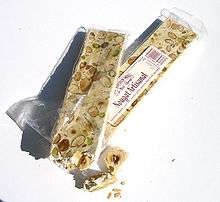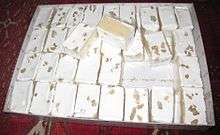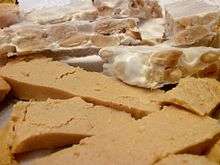Nougat
 Nougat bar | |
| Type | Confection |
|---|---|
| Main ingredients |
White nougat: sugar or honey, nuts (almonds, walnuts, pistachios, hazelnuts), egg whites, sometimes candied fruit Brown nougat: sugar or honey, nuts (almonds, walnuts, pistachios, hazelnuts) Viennese or German nougat: sugar, chocolate, nuts |
| Variations | Gaz (candy), Torrone and turrón |
| 200 kcal (837 kJ) | |
|
| |
Nougat (US pronunciation: /ˈnuːɡət/ NOO-gət, UK /ˈnuːɡɑː/ NOO-gaa, or UK /ˈnʌɡət/ NUG-ət;[1][2][3][4] French pronunciation: [nu.ɡa]) is a family of confections made with sugar or honey, roasted nuts (almonds, walnuts, pistachios, hazelnuts, and macadamia nuts are common), whipped egg whites, and sometimes chopped candied fruit. The consistency of nougat is chewy, and it is used in a variety of candy bars and chocolates. The word nougat comes from Occitan pan nogat (pronounced [ˈpa nuˈɣat]), seemingly from Latin panis nucatus 'nut bread' (the late colloquial Latin adjective nucatum means 'nutted' or 'nutty').
There are three basic kinds of nougat. The first, and most common, is white nougat (mandorlato or torrone in Italy, turrón in Spain), made with beaten egg whites and honey; it appeared in Cologna Veneta, Italy, in the early 15th century, in Alicante, Spain with the first published recipe in the 16th century,[5] and in Montélimar, France, in the 18th century. The second is brown nougat (nougat noir in French, literally "black nougat"), which is made without egg whites and has a firmer, often crunchy texture. The third is the Viennese or German nougat which is essentially a chocolate and nut (usually hazelnut) praline.
History
Many legends exist around nougat’s origins. The early recipes of white nougat, probably borrowed from Central Asia, were found in a Middle Eastern book in Baghdad the 10th century. That nougat was called ناطف nāṭif.[6] One of these recipes indicates that the nāṭif comes from Harran, a city located between Urfa (now in southeast Turkey) and Aleppo, Syria. Mention of nāṭif was found in a triangle between Urfa, Aleppo, and Baghdad. At the end of the 10th century, the traveler and geographer Ibn Hawqal wrote that he ate some nāṭif in Manbij (in modern Syria) and Bukhara (in modern Uzbekistan).[7]
Distribution and popularity
In southern Europe, where it is likely to have originated,[8] nougat is largely associated with the Christmas season.

Turrón, a candy related to the traditional French nougat, is produced in Spain (where it also has the Catalan name called torró), in some neighboring parts of France, in Cremona, Taurianova and Sicily in Italy (where it is called torrone or cupeta (from Latin cupedia;[9] the most famous Sicilian nougat is called cubbaita), Greece (where it is known as mandolato or mandola), Malta (where it is known as qubbajd and sold in village festivals), and in local variant form in Tabriz in Iran with the same name as in Malta.
The nougat that appears in many modern candy bars in the United States and United Kingdom is different from traditional recipes, being a mixture of sucrose and corn syrup aerated with a whipping agent such as egg white or hydrolyzed soya protein or gelatine. It may also include vegetable fats and milk powder. This type of nougat is often used as a filler by large candy companies, since it's inexpensive to make. Typically it is combined with nuts, caramel, or chocolate. But some American confections feature such nougat as the primary component, rather than one of several. Varieties of nougat are found in Double Decker, ZERO bars, and Baby Ruth bars.
In Britain, nougat is traditionally made in the style of the southern European varieties, and is commonly found at fairgrounds and seaside resorts. The most common industrially produced type[10] is coloured pink and white, the pink often fruit flavoured, and sometimes wrapped in edible rice paper with almonds and cherries.
Variations


Spanish turrón follows the traditional recipes with toasted almonds, sugar, honey, and egg whites. It has a minimum 60% almond content.
Torrone from Italy includes these same basic ingredients as well as vanilla or citrus flavoring, and is often sandwiched between two very thin sheets of rice paper.[11] The Venetian town of Cologna Veneta is well known for its nougat production, especially the type called mandorlato, always based on honey, sugar, egg whites, and almonds (also known as mandorle in Italian) but with a different taste and harder to bite than torrone.
"Wiener (Viennese) Nougat" is a variant which contains only sugar, cocoa butter, nuts, and cocoa mass, and has a mellow consistency. The nuts used for Viennese nougat are usually hazelnuts. In both Germany, Sweden and Denmark, Viennese nougat is what has traditionally been associated with and labelled as nougat,[12][13] while in Sweden and Denmark the original nougat is referred to as "French nougat".[14][15] In Germany, gianduja is traditionally called nougat.
See also
References
- ↑ "nougat". OxfordDictionaries.com. Oxford University Press. Retrieved 30 June 2016.
- ↑ "nougat". Cambridge Dictionary Online. Cambridge University Press. Retrieved 19 August 2013.
- ↑ "nougat". Dictionary.com. Retrieved 19 August 2013.
- ↑ "nougat". TheFreeDictionary.com. Retrieved 19 August 2013.
- ↑ Anonymous (2000) [c. 1550]. Majada Neila, Jesús, ed. "Manual de mujeres en el cual se contienen muchas y diversas recetas muy buenas" (in Spanish). Caligrama. ISBN 9788493176341. Retrieved 2 November 2016 – via Biblioteca Virtual Miguel de Cervantes.
- ↑ Derived from the triliteral root nṭf 'to dribble, to trickle', literally denoting a white viscous mass, as in ناطف الحوت nāṭif al-ḥūt, 'spermaceti'. Source: "ترجمة ومعنى كلمة ناطف" [Translation and meaning of the word nāṭif]. Almaany.com (in Arabic). Retrieved 26 June 2016.
- ↑ Moncorgé, Marie Josèphe (2013). "Le nougat dans tous ses états, une histoire méditerranéenne de confiserie" (in French). Tambao Livres. Lay summary.
- ↑ "Nougat". Linda's Culinary Dictionary. Retrieved 7 May 2008.
- ↑ "Torrone di Benevento". sito.regione.campania.it (in Italian). Retrieved 12 February 2016.
- ↑ "Barrat Nougat Bar Sweets product reviews and price comparison". DooYoo.co.uk. Retrieved 12 February 2016.
- ↑ Gangi, Roberta (2005). "Sicilian Torrone". Best of Sicily Magazine. Retrieved 7 May 2008.
- ↑ Odense: Nougat - ingredients (Danish)
- ↑ Odense: Blød Nougat Pictures and description. (Danish)
- ↑ "Fransk Nougat". Politiken.dk (in Danish). Københavns Madhus. 17 December 2010. Retrieved 31 August 2014.
- ↑ Marabou. "Fransk Nougat". nemlig.com (in Danish). Retrieved 31 August 2014.